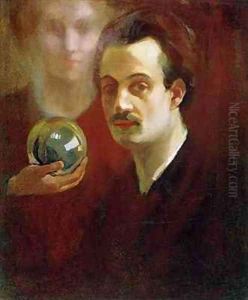Khalil Gibran Paintings
Kahlil Gibran, also known as Gibran Khalil Gibran, was born on January 6, 1883, in the town of Bsharri, in modern-day Lebanon, then part of Ottoman Empire. He was a poet, writer, and artist, best known for his book 'The Prophet', a series of poetic essays. His work, which combines elements of Eastern and Western philosophy, has been widely translated and continues to be appreciated for its deep spiritual insight and artistic beauty.
Gibran's early life in Lebanon was marked by tragedy, including the death of his father and poverty. His mother, Kamila, emigrated with her children to the United States in 1895, settling in Boston's South End. There, Gibran's artistic talents were nurtured by his teachers and by the photographer, publisher, and art patron Fred Holland Day. He received his early education in art and literature at a local school, where he learned English and began to develop his literary talents.
Gibran returned to Lebanon in 1898 to continue his studies, and he immersed himself in Arabic literature. However, he returned to the United States in 1902. Over the next few years, Gibran would study art in Paris and begin to publish both written and visual works. His early writings were in Arabic, and he became associated with the Mahjar literary movement—comprised of Arab emigrants who were working in North America. Gibran's early works were notable for their call for political and social liberation, and they also reflected his personal experiences as an immigrant.
His transition to writing in English came with the guidance of Mary Haskell, a school headmistress who would become his lifelong benefactor and confidant. Under her support, Gibran moved to New York City in 1912 and began to pursue a career as a writer and artist. There, he wrote 'The Madman' (1918) and 'The Forerunner' (1920), which foreshadowed his most famous work, 'The Prophet', published in 1923. This book became particularly popular in the 1960s counterculture movement and remains in print today, having been translated into over 50 languages.
As an artist, Gibran's work was also well-received, with his ethereal drawings and paintings reflecting his interest in mysticism and the human condition.
Kahlil Gibran died on April 10, 1931, in New York City, at the age of 48, from cirrhosis of the liver and tuberculosis. His body was returned to Lebanon, where he is revered as a literary hero. Gibran's legacy as a significant figure in literature and art endures, with his philosophical and spiritual writings having a lasting impact on readers around the world.
